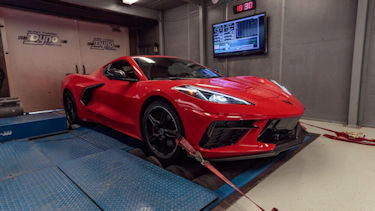2020 Dyno Test
I'm looking through a window, hands around my face, staring at a screen with all sorts of graphics and numbers that are too small to read. On the other side of the window, a red 2020 Chevrolet Corvette is strapped to the dyno with its rear wheels spinning very, very fast.
The double-paned windows are not enough to keep the engine note from reaching other parts of the facility. The speedometer on the screen reads 150 mph, but the front wheels are not moving at all. Once the engine noise winds down and the wheels stop spinning, the numbers we're looking for pop up on the screen-558 hp and 515 lb-ft of torque at the wheels. "We've got a hot rod!" says international bureau chief Angus MacKenzie, who has been standing next to me all this time.

We're in shock. A quick math check reveals that's an estimated 656 hp and 606 lb-ft of torque at the crank if we assume a 15-percent drivetrain loss-way over the 495 hp and 470 lb-ft that Chevy claims. (That 15 percent represents the power consumed by everything between the engine crankshaft and the drive wheels, including inertia of all the spinning parts, power to run the hydraulic pump in an automatic or twin-clutch transmission, the drag that occurs when gears spin through lubricating oil, friction between the gear teeth, etc. It's an educated guestimate frequently used across the industry for modern light-duty automatic transmissions-manuals experience slightly smaller losses; older or heavier-duty automatics slightly larger ones.
But let's rewind. Earlier that morning, Chevrolet dropped the 2020 Corvette with VIN 10 at our headquarters in El Segundo, California, to perform a Real MPG test by our partners at EQUA. The early-built production car was shipped from the plant in Bowling Green, Kentucky, to Milford Proving Ground in Michigan for a check before it made it down to Southern California. The Corvette was tested by MotorTrend the week prior at Fontana and a few days later at the Hyundai-Kia proving ground for our Car of the Year competition. The 'Vette spent every night under the vigilance of the Chevrolet public relations team and was handed back to the editorial team in the mornings. The evening prior to the dyno run, the Corvette was driven by an editor from Tehachapi, California, to our headquarters, where it was taken by the Chevy team for the night.
That sunny September morning, the EQUA technician told us he didn't have the right equipment for the test-he needed a different set of tubes to seal around the exhaust outlets; the ones he had wouldn't resist the higher temperature from a mid-engine sports car. Our Plan B? Take it to the dyno before the Corvette got on a trailer to go back to Michigan that evening.
Which is how Angus and I ended up staring through the glass at those surprising numbers. We asked the dyno technician to run the test in fifth gear after a call Angus and I had with Chris Walton, our road test editor, who estimated that fifth gear could probably be the closest 1:1 ratio. (A call with Chevy would later confirm that, but more on that later.) We decided to run the test again.
The massive fan starts to blow air straight at the Corvette as the rear wheels start moving. Our attention shifts to the screen-558 hp and 512 lb-ft at the wheels, almost identical numbers as the first run. Assuming a 15-percent drivetrain loss, those numbers go up to about 656 hp and 602 lb-ft. Still too high. What is going on?
Source: Miguel Cortina - Words, Motor Trend Staff
Posted 10/25/19